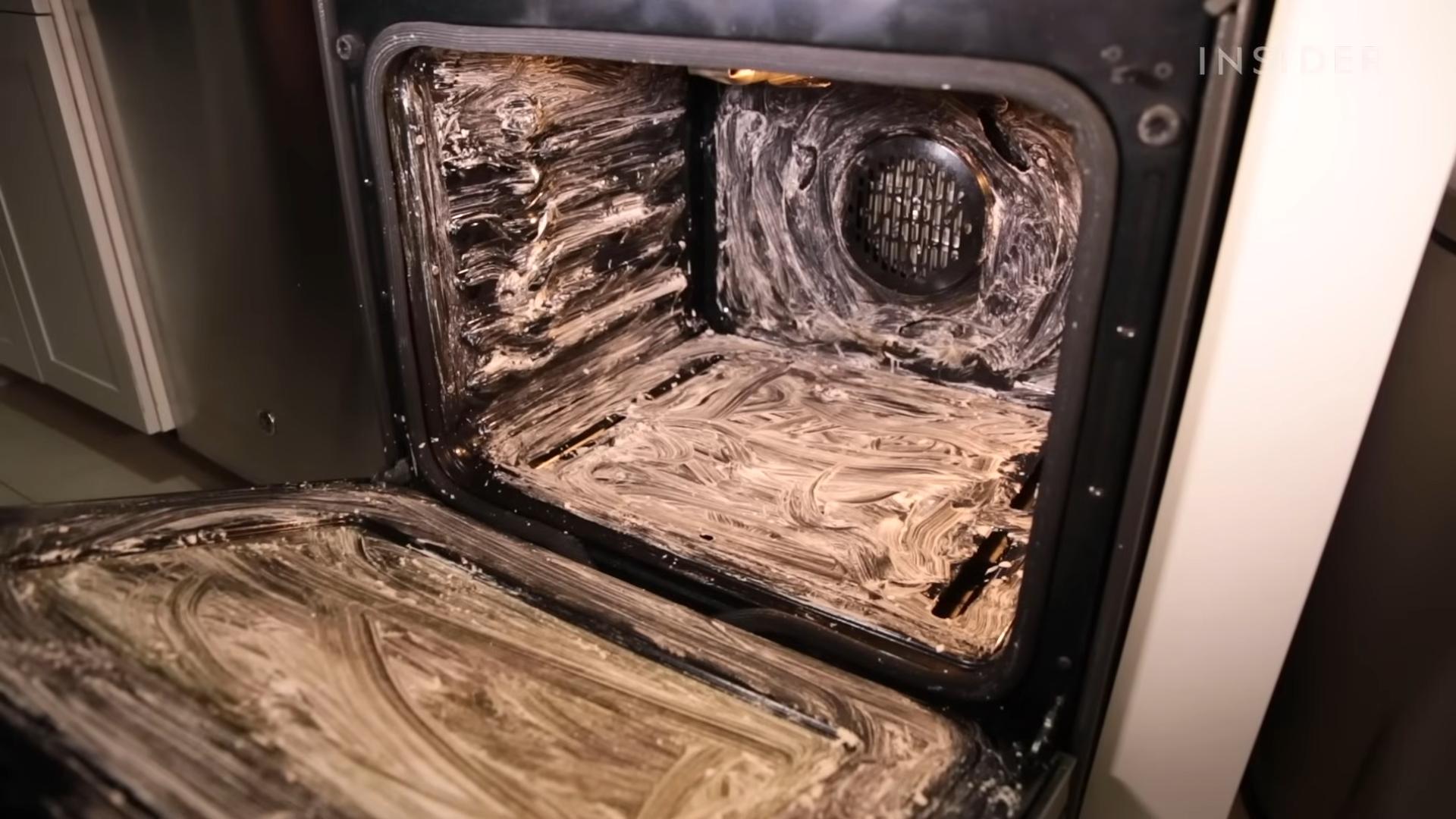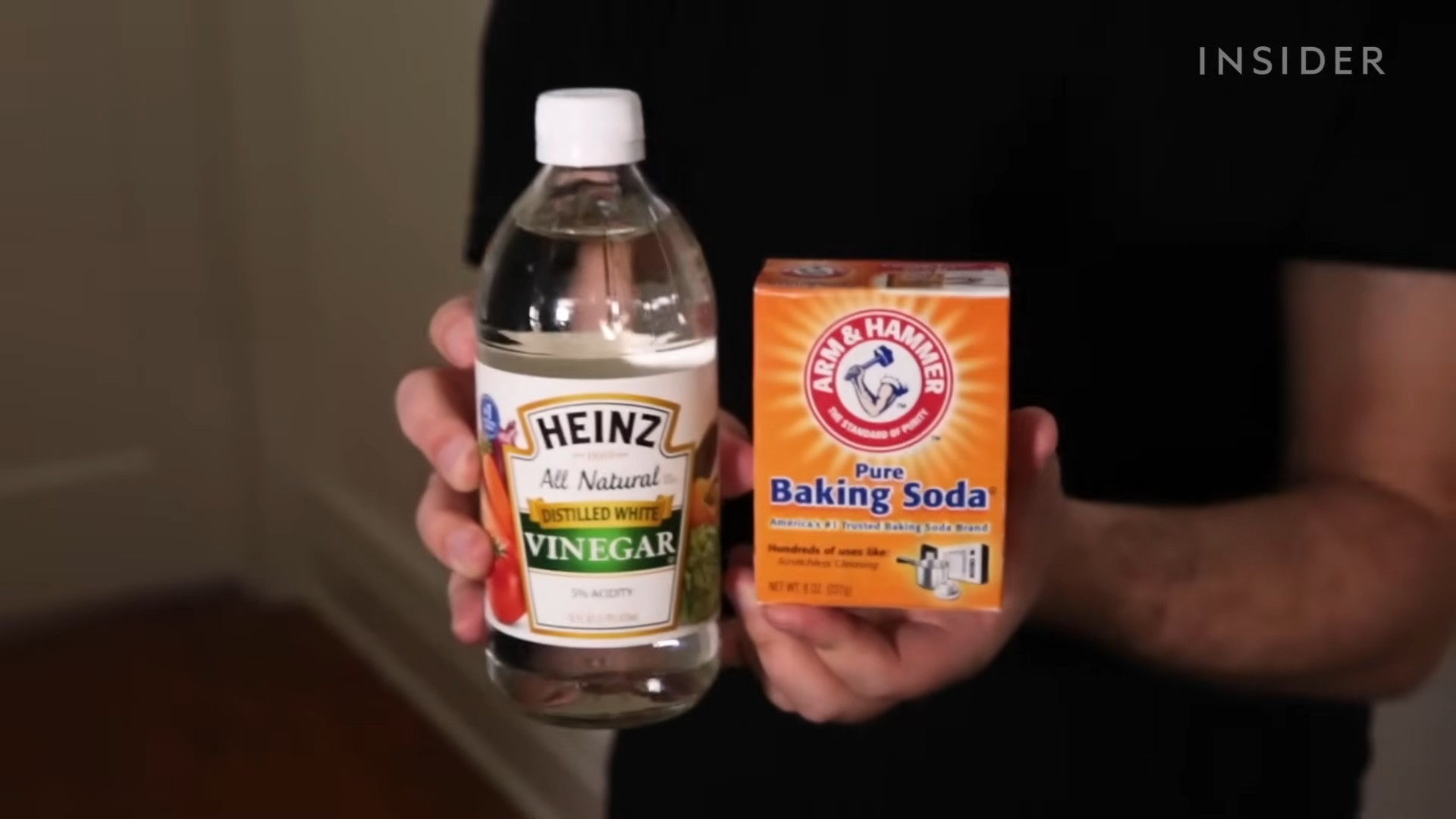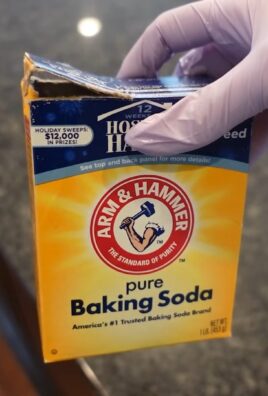Clean oven baking soda vinegar – sounds like a science experiment, right? Well, in a way, it is! But trust me, it’s a science experiment that will leave your oven sparkling and you feeling like a domestic goddess (or god!). For generations, folks have relied on the power of simple, natural ingredients to keep their homes clean. Think about it – before fancy chemical cleaners, our grandmothers were using baking soda and vinegar for everything from unclogging drains to freshening up carpets. It’s a testament to their effectiveness and their eco-friendliness.
Let’s be honest, cleaning the oven is nobody’s favorite chore. It’s messy, it’s time-consuming, and those harsh chemical cleaners can be downright unpleasant. But a dirty oven affects everything from the taste of your food to its energy efficiency. That’s where this DIY trick comes in! I’m going to show you how to clean oven baking soda vinegar method, a simple, safe, and incredibly effective way to get your oven looking brand new without all the fuss. Get ready to ditch the harsh chemicals and embrace the power of natural cleaning!

DIY Oven Cleaning with Baking Soda and Vinegar: A Sparkling Clean Oven Awaits!
Okay, let’s face it: cleaning the oven is nobody’s favorite chore. But a sparkling clean oven makes cooking so much more enjoyable (and probably even helps your food cook more evenly!). Forget those harsh chemical cleaners – I’m going to show you how to clean your oven using just baking soda and vinegar. It’s natural, effective, and way easier on your lungs. Trust me, you’ll be amazed at the results!
What You’ll Need:
Before we dive in, let’s gather our supplies. This is a pretty simple process, so the list is short and sweet:
* Baking Soda: The star of the show! We’ll use it to create a powerful cleaning paste.
* White Vinegar: This will react with the baking soda to create a fizzing action that helps loosen grime.
* Water: For mixing and rinsing.
* Spray Bottle: To apply the vinegar.
* Spatula or Scraper: To help remove stubborn baked-on messes. A plastic one is ideal to avoid scratching the oven surface.
* Sponge or Cloth: For wiping and scrubbing.
* Rubber Gloves: To protect your hands. Baking soda can be drying.
* Old Towels or Rags: For soaking up spills and wiping down the oven.
* Small Bowl: For mixing the baking soda paste.
* Trash Bag or Newspaper: To protect your floor from drips.
Step-by-Step Instructions:
Alright, let’s get this oven sparkling! Here’s the breakdown:
1. Prep Your Oven:
* First things first, unplug your oven or turn off the breaker. Safety first!
* Remove the oven racks, pizza stone, thermometer, or anything else inside. We’ll clean the racks separately.
* Place a trash bag or newspaper on the floor in front of your oven to catch any drips or spills.
2. Make the Baking Soda Paste:
* In your small bowl, mix 1/2 cup of baking soda with enough water to form a spreadable paste. You want it to be thick enough to stick to the oven walls, but not so thick that it’s difficult to apply. I usually start with a few tablespoons of water and add more gradually until I get the right consistency.
3. Apply the Paste:
* Put on your rubber gloves (trust me, you’ll thank me later!).
* Using your hands or a spatula, spread the baking soda paste all over the inside of your oven. This includes the walls, the floor, the door (inside), and even the heating elements (if you can reach them safely – be careful not to damage them!).
* Avoid the heating elements if you are not comfortable cleaning around them.
* Make sure to apply a thicker layer to areas with particularly stubborn baked-on messes.
4. Let it Sit (and Work its Magic!):
* This is the most important part! Let the baking soda paste sit for at least 12 hours, or even overnight. The longer it sits, the more time it has to loosen the grime. I usually apply the paste before I go to bed and then clean the oven the next morning.
* If you’re short on time, you can try letting it sit for a minimum of 3 hours, but overnight is really the best.
5. Clean the Oven Racks:
* While the baking soda paste is working its magic inside the oven, let’s tackle those racks.
* There are a couple of ways to do this:
* Option 1: The Bathtub Soak: Line your bathtub with old towels to protect the surface. Place the oven racks in the tub and cover them with hot water. Add about 1/2 cup of dish soap and 1/2 cup of baking soda to the water. Let them soak for several hours, or even overnight. Then, scrub them with a sponge or brush and rinse thoroughly.
* Option 2: The Trash Bag Method: Place each rack inside a large trash bag. Add about 1/4 cup of dish soap and 1/4 cup of baking soda to the bag. Seal the bag tightly and shake it around to distribute the soap and baking soda. Let it sit for several hours, or even overnight. Then, remove the racks from the bag, scrub them with a sponge or brush, and rinse thoroughly.
6. Wipe Away the Baking Soda Paste:
* After the baking soda paste has had its time to work, it’s time to wipe it away.
* Using a damp sponge or cloth, start wiping away the paste. You’ll likely need to rinse your sponge or cloth frequently as you go.
* For stubborn areas, use your spatula or scraper to gently loosen the grime before wiping.
* This part can take a little elbow grease, but don’t give up! You’ll start to see the clean oven underneath.
7. Vinegar Time!
* Once you’ve removed as much of the baking soda paste as possible, it’s time for the vinegar.
* Pour some white vinegar into your spray bottle.
* Spray the inside of the oven with vinegar. The vinegar will react with any remaining baking soda, causing it to fizz. This fizzing action helps to loosen any remaining grime.
8. Final Wipe Down:
* Using a clean, damp sponge or cloth, wipe away the vinegar and any remaining residue.
* Rinse your sponge or cloth frequently.
* Keep wiping until the oven is clean and free of any baking soda or vinegar residue.
9. Reassemble and Dry:
* Once the oven is clean, replace the oven racks.
* Leave the oven door open for a few hours to allow it to air dry completely. This will help to prevent any lingering vinegar smell.
10. Admire Your Sparkling Clean Oven!
* That’s it! You’ve successfully cleaned your oven using baking soda and vinegar. Now, stand back and admire your sparkling clean oven. You deserve it!
Dealing with Stubborn Stains:
Sometimes, you might encounter some extra stubborn stains that just won’t budge with the regular baking soda and vinegar treatment. Don’t worry, I’ve got a few tricks up my sleeve!
* Extra Baking Soda Paste: For particularly stubborn stains, apply a thicker layer of baking soda paste and let it sit for even longer – up to 24 hours.
* Lemon Juice: Lemon juice is a natural degreaser and can help to break down tough stains. Cut a lemon in half and rub it directly onto the stain. Let it sit for about 30 minutes, then wipe it away with a damp sponge.
* Steel Wool (Use with Caution!): As a last resort, you can try using steel wool to scrub away stubborn stains. However, be very careful not to scratch the oven surface. Test it in an inconspicuous area first to make sure it doesn’t cause any damage. I personally avoid this method unless absolutely necessary.
Maintaining Your Clean Oven:
Now that you’ve put in all that effort to clean your oven, you’ll want to keep it clean! Here are a few tips for maintaining your sparkling oven:
* Wipe Up Spills Immediately: The best way to prevent baked-on messes is to wipe up spills as soon as they happen.
* Use Oven Liners: Oven liners can help to catch drips and spills, making cleanup much easier.
* Regular Cleaning: Try to clean your oven at least once every few months to prevent buildup. A quick wipe-down after each use can also help.
Important Safety Tips:
* Always unplug your oven or turn off the breaker before cleaning.
* Wear rubber gloves to protect your hands.
* Be careful when cleaning around the heating elements.
* Avoid getting baking soda or vinegar in your eyes.
* If you’re using steel wool, be careful not to scratch the oven surface.
* Ensure the oven is completely dry before using it again.
I hope this guide helps you achieve a sparkling clean oven without the use of harsh chemicals. Happy cleaning!

Conclusion
So, there you have it! This simple, yet incredibly effective, DIY trick using baking soda and vinegar to clean your oven is a game-changer. Forget harsh chemicals, lingering fumes, and back-breaking scrubbing. This method harnesses the natural power of readily available ingredients to deliver a sparkling clean oven, leaving you with more time to focus on what truly matters: creating delicious meals and enjoying them with loved ones.
Why is this a must-try? Because it’s safe, cost-effective, and genuinely works. Commercial oven cleaners are often loaded with chemicals that can be harmful to your health and the environment. This baking soda and vinegar solution offers a natural alternative that is gentle yet powerful enough to tackle even the most stubborn baked-on grime. Plus, you likely already have these ingredients in your pantry, making it an incredibly convenient option.
But the benefits don’t stop there. This method is also incredibly versatile. For instance, if you have particularly tough stains, you can create a thicker paste of baking soda and water and let it sit overnight before applying the vinegar. You can also add a few drops of your favorite essential oil, like lemon or lavender, to the vinegar solution for a fresh, clean scent. Another variation involves using a pumice stone (carefully!) on particularly stubborn baked-on spots after the baking soda and vinegar have done their work. Always test a small, inconspicuous area first to ensure the pumice stone doesn’t scratch the oven surface.
We understand that trying new things can sometimes feel daunting, but trust us, this is one DIY project you won’t regret. The satisfaction of seeing your oven transform from a greasy mess to a gleaming appliance is incredibly rewarding. And the best part? You’ll know you achieved it using a safe and natural method.
We are confident that this baking soda and vinegar oven cleaning method will become your go-to solution for maintaining a spotless oven. It’s a simple, effective, and eco-friendly way to keep your kitchen looking its best.
So, what are you waiting for? Give it a try! We’re eager to hear about your experience. Share your before-and-after photos and your tips and tricks in the comments below. Let’s create a community of clean oven enthusiasts! We believe that sharing our experiences will help others discover the magic of this simple yet powerful cleaning solution. Your insights could be invaluable to someone struggling with a particularly dirty oven.
Don’t be shy – let us know how this DIY trick worked for you. Did you try any variations? Did you encounter any challenges? Your feedback is essential in helping us refine and improve this method for everyone. Together, we can conquer oven grime and enjoy the satisfaction of a sparkling clean kitchen. Happy cleaning!
Frequently Asked Questions (FAQs)
Q: Is baking soda and vinegar safe to use in my oven?
A: Absolutely! Baking soda and vinegar are both natural and non-toxic cleaning agents. They are much safer to use than commercial oven cleaners, which often contain harsh chemicals that can be harmful to your health and the environment. However, it’s always a good idea to wear gloves when cleaning to protect your skin, and ensure proper ventilation in your kitchen. While the reaction between baking soda and vinegar is generally safe, avoid direct contact with your eyes.
Q: Will this method work on a self-cleaning oven?
A: While this method is generally safe for most ovens, it’s always best to consult your oven’s manual before using any cleaning method, especially on a self-cleaning oven. Some self-cleaning ovens have specific coatings or components that could be damaged by baking soda or vinegar. If your manual advises against using these ingredients, it’s best to follow those instructions. However, many people have successfully used this method on self-cleaning ovens without any issues, but proceed with caution and at your own risk.
Q: How long should I leave the baking soda paste in the oven?
A: For best results, leave the baking soda paste in the oven for at least 12 hours, or even overnight. This allows the baking soda to penetrate and loosen the baked-on grime. If you’re short on time, you can try leaving it for a minimum of 3-4 hours, but the longer you leave it, the easier it will be to scrub away the dirt.
Q: What if the vinegar doesn’t bubble when I spray it on the baking soda?
A: The bubbling reaction between baking soda and vinegar is what helps to loosen the grime. If you don’t see bubbling, it could be because the baking soda paste is too dry, or the vinegar is not acidic enough. Try adding a little more water to the baking soda paste to make it slightly wetter. You can also try using a different brand of vinegar, as some brands may be more acidic than others. Ensure you are spraying the vinegar directly onto the baking soda paste for the best reaction.
Q: How do I clean the oven racks using baking soda and vinegar?
A: Cleaning oven racks with baking soda and vinegar is easy! Fill your bathtub or a large container with hot water and add about 1 cup of baking soda and 1/2 cup of vinegar. Submerge the oven racks in the water and let them soak for several hours, or even overnight. The baking soda and vinegar will help to loosen the grime. After soaking, scrub the racks with a brush or sponge to remove any remaining dirt. Rinse them thoroughly with clean water and let them dry completely before putting them back in the oven.
Q: Can I use this method to clean the oven door glass?
A: Yes, you can use this method to clean the oven door glass. Apply the baking soda paste to the glass and let it sit for a few hours. Then, spray the vinegar onto the paste and wipe away the grime with a cloth or sponge. For stubborn stains, you may need to scrub a little harder. You can also use a razor blade scraper (carefully!) to remove any remaining baked-on residue. Be sure to avoid scratching the glass.
Q: What if I have a really dirty oven? Will this method still work?
A: This method can still work on a very dirty oven, but it may require a little more effort and patience. You may need to repeat the process several times, or let the baking soda paste sit for a longer period of time. You can also try using a stronger concentration of baking soda and vinegar. For example, you can make a thicker paste of baking soda and water, or use a higher percentage of vinegar in your spray bottle. Don’t be discouraged if it doesn’t come clean on the first try – persistence is key!
Q: How often should I clean my oven using this method?
A: The frequency of cleaning depends on how often you use your oven and how messy it gets. As a general rule, it’s a good idea to clean your oven every 3-6 months. However, if you notice a lot of spills or splatters, you may need to clean it more frequently. Regular cleaning will prevent the buildup of baked-on grime and make it easier to maintain a clean oven.
Q: What are some other uses for baking soda and vinegar in cleaning?
A: Baking soda and vinegar are incredibly versatile cleaning agents that can be used for a variety of purposes around the house. They can be used to unclog drains, clean countertops, deodorize carpets, remove stains from clothing, and much more. Their natural and non-toxic properties make them a safe and effective alternative to harsh chemical cleaners. Experiment and discover all the amazing ways you can use baking soda and vinegar to keep your home clean and fresh!




Leave a Comment